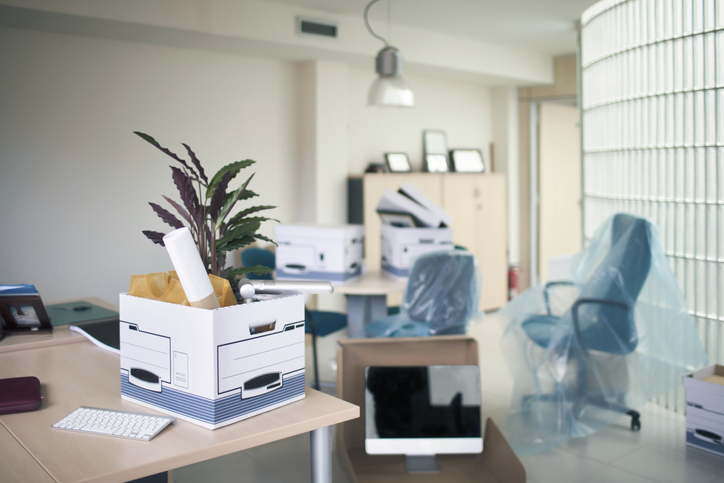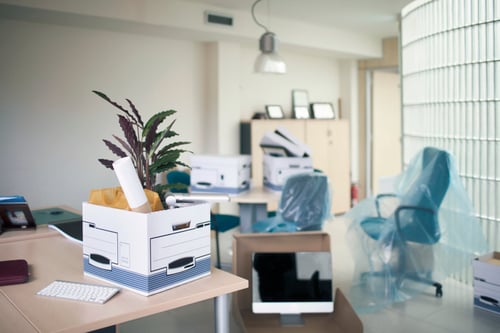Our Business Moving Checklist Makes Moving Easier

Whether you are moving your business headquarters, office, or store across town or across the state, a little organization goes a long way. A move for something as important as your business shouldn't be done haphazardly. The more organized and planned your move is, the more smoothly it will go. It's important to begin planning weeks before the actual move, not days.
SiteBox Storage, has been helping its customers stay organized since it started in the portable storage business in 1998. To help you plan your move, we've created a simple checklist. Not all steps may apply to your unique situation. But this should help you as you get ready to move.
1. Eight weeks before moving your business, headquarters, or office
 Yes, planning should start at least two months before the move. Very few moves are spur of the moment. But many times, business owners and staff put things off to the last minute.
Yes, planning should start at least two months before the move. Very few moves are spur of the moment. But many times, business owners and staff put things off to the last minute.
- Create a readily available, accessible file or files that can be shared with your business team leaders. This can be done on a file located on your local server, or in the cloud using Google Drive or Microsoft's OneDrive. For example, create a spreadsheet to track moving expenses. Another useful file to create is one that lists all items that must be addressed and who is assigned to them. Once a task is completed, the task owner can mark it off, adding notes about the process. This keeps everyone informed without having to disrupt regular business communications.
- Schedule a moving company if need one to transport your office furniture, files, fixtures, and other business paraphernalia that you need to set up at the new location. Scheduling in advance ensures that the moving company will be available. Many moving companies have their trucks, trailers, and moving equipment slated several weeks out. Make sure you're on their calendar.
- Move some items in advance, keeping the inherent chaos of moving day to a minimum. However, many moving companies don't want to tie up their vans and trailers as storage units for an extended time. In that situation, you may want to schedule and obtain either rental storage units or, if possible, onsite storage containers. Container storage has many benefits and if using storage containers on the premises, make sure they're sturdy enough and designed to keep your office equipment secure from vandals. Additionally, they should keep your office belongings dry during inclement weather, and be rodent and pest proof.
- Determine the best location for the storage container. If storing onsite, talk to the container storage company and have a plan. Often there are space requirements for unloading the container. Knowing what they are in advance will keep last-minute changes to a minimum.
- Create an inventory of things to be moved and determine if they can be relocated immediately or need to be closer to the actual moving date. By developing this list, items can be segregated to ensure a smooth transition and make sure that critical items are not moved too soon.
- Research services in your new location to make sure you have any help you need at the time of your move. For example, you may need the services of a plumber, electrician, or mechanical company for heat and air services. Doing this in advance will ensure you get a reputable technician that can be trusted. And it keeps you from having to do an eleventh-hour search once you arrive.
- Get your paperwork in order. Make sure you have all the necessary permits and are in compliance with any laws and zoning ordinances. Variances are hard to come by. Make sure your move will be up to regulations.
2. Six Weeks Before Moving Day
You're still a few weeks out, so pre-planning is essential. It's time to get the supplies you'll need for transporting your office supplies and equipment.
- Any needed boxes, tape, and padlocks should be identified and ordered. Anything that must be protected against damage during the move may need moving blankets, tarps, or other packaging materials.
- Contact a local bank if yours doesn't have a branch in the new location. Any accounts you'll need should be set up in advance.
- If you need a healthcare provider to handle your health insurance and other medical needs, research and secure this well in advance. While you may have insurers that operate nationwide, it would be a good idea to find out if there is a local office in your new location.
- Now would be a good time to make a video or photo inventory of your office equipment. While most movers take great care to ensure there is no damage, a photo or video will make any damage claims easier should damage occur during transport or set up.
3. Three to Four Weeks from the Big Move
You're starting to get closer to the big day. It's time to wrap up any loose ends that would slow down the transition process.
- Start organizing and packing nonessential items. If using boxes and other shipping containers, make sure each one is marked, and if possible, an inventory made of all items in the box. This list can be kept on a spreadsheet, as noted in #1 above. Additionally, if a packed item is needed for some reason, you'll know exactly where to look.
- This may sound obvious, but take time to clean and sanitize items as you pack them. You might want to hire this out, but it will pay off later. There's nothing more frustrating than moving into your new office or headquarters, only to realize that a lot of cleaning must be done before you open your doors.
- Transfer utilities. Schedule your office's utilities to be turned on at the new location and make arrangements to have them disconnected at your current one.
- Forward the mail. Do you have any magazines, newspapers, or other subscriptions delivered to your current office? If so, make sure you inform them of your new address. And make sure your local post office knows when and where to forward your business mail.
4. One to Two Weeks from Moving Day
If you've been following your moving plan, you shouldn't be too stressed as the date approaches. However, go over your lists and take stock of anything not completed yet. There are other last-minute items to attend to.
- Schedule a cleaning service to arrive after you leave. Part of your current lease agreement may require a thorough cleaning after your departure.
- If there is any damage to the present office or building that must be repaired, contract the appropriate services.
- If you haven't done so already, make sure all of your customers or clients are aware of your new location. Even if you will no longer be interacting with them, it's a courtesy to do so. Imagine how you would feel if you rolled up to a business and the doors were closed, the building empty. Additionally, your happy customers may contact friends and acquaintances in your new location to recommend your business.
- If possible, start setting up the new site with those items that are essential for your business to open. Anything that can be placed in the new office should be. Schedule pick up of any storage containers you no longer need. If you've chosen a reputable, customer-friendly service, the containers will be picked up before you open your doors.
- A mobile office can make the transition easier, even if your new location isn't ready to open. Some employees may be able to start the transition process early, making sure essential tasks are up and running.
5. The Time Has Come! You're Moving Today
If you've taken care of everything in advance, you should be ready to go. It's going to be an exciting event as you leave the old location and set up shop in the new. Do a thorough walk-around in the old office or store before you lock the doors. It's surprising how many things hide in corners, often essential items you'll need.
Then, celebrate and head on down the road. And give yourself a pat on the back for making sure your transition to the new location was well-planned and executed.
If you need onsite storage containers in our Midwest service areas, be sure to contact us about container storage options. Whether you have a small, cozy office or a huge corporate headquarters, our customer-friendly service reps will help you make the decision that's right for you.

